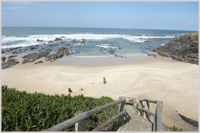 Visitors to Portugal who fly into Lisbon Airport tend either to head south to the Algarve or north to Estoril, Cascais, the city of Porto and the Douro Region.
Visitors to Portugal who fly into Lisbon Airport tend either to head south to the Algarve or north to Estoril, Cascais, the city of Porto and the Douro Region.
In doing so, they inadvertently miss out on two of the most traditional and interesting regions of the country. Both the Centro region – immediately north of Lisbon – and the Alentejo region – between Lisbon and the Algarve – are areas that tend to be driven through quickly yet, together, they make up half of Portugal, and both deserve to be visited in their own right.
The Alentejo was known as the bread basket of Portugal and it boasts some of the country’s tastiest dishes. The countryside is made up of wide, sweeping plains interspersed with medieval hilltop villages topped by dramatic castles. In spring the region is awash with colour – the fields are full of flowers of red, yellow, white and purple or blue hues. The Alentejo produces 46% of Portugal’s excellent wine but has a mere 6% of its population. It is quiet, it is uncrowded and it is beautiful.
In the summer it’s very hot – in fact, the hottest place in Portugal. Around May/June, depending on the weather, they harvest the cork trees; this is the region of the cork oak tree and the economy of the Alentejo still depends to a considerable degree upon this wonderful natural product. Portugal is the largest cork exporter in the world. NASA uses Alentejo cork to insulate the cones of its space capsules and to protect them from heat damage on re-entry to the earth’s atmosphere. And cork is not only for wine bottles – you can buy cork jewellery, cork umbrellas, cork iPad covers – in fact, just about anything and everything can these days be manufactured from cork.
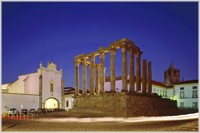 Evora, just a 75-minute drive inland from Lisbon on uncrowded roads, is the capital of the Alentejo (which means below the Tejo, or Tagus, river). It is steeped in history, yet really alive and buzzing courtesy of the university within its ancient walls. It was the seat of the Kings of Portugal in the 15th and 16th centuries and is a UNESCO World Heritage Site in its entirety.
Evora, just a 75-minute drive inland from Lisbon on uncrowded roads, is the capital of the Alentejo (which means below the Tejo, or Tagus, river). It is steeped in history, yet really alive and buzzing courtesy of the university within its ancient walls. It was the seat of the Kings of Portugal in the 15th and 16th centuries and is a UNESCO World Heritage Site in its entirety.
The Atlantic coastline, south of Lisbon, is like that of the Algarve 50 years ago and much of it is protected by law. Coastal villages like Porto Covo and Vila Nova de Milfontes are firm favourites yet have escaped mass development and still have great character; they are ideal for a lazy summer holiday and perhaps a little gentle coastal walking on a well-marked pathway, the Rota Vicentina, if that appeals. The coast is a few degrees cooler than inland, often with a pleasant breeze in the height of summer. Beaches are many and seldom crowded, even in the peak of the season.
So why have so few people heard of this region? It’s a very rural area with some excellent accommodation of character but local politics has meant an initial lack of interest in tourism, making it a latecomer to the travel game. This very fact will stand it in good stead – it has been able to learn from mistakes made elsewhere.
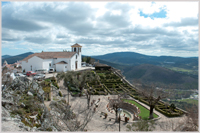 The north of the Alentejo region is next-door to Centro, the central region of Portugal or, as I prefer to call it, the Heart of Portugal. This is an area that stretches from its Atlantic coastline, with long beaches stretching for miles, into a mountainous region with some historic fortified villages and castles along the border with Spain that defended Portugal from invasion in the Middle Ages. The most impressive are Almeida, Castelo Rodrigo, Monsanto, Sortelha, Piodao and Idanha-A-Velha. These castles and villages conjure up images of knights in armour, of damsels in distress and heroic deeds. Legends abound in this area which, in turn, was overrun by the Romans, Moors and Spanish. Tales are recounted of epic battles and ancient rituals, and religious festivals are still very much part of daily life. The Serra da Estrela national park is snow bound in winter and, in the summer, ideal for walks with breathtaking views across forested landscapes.
The north of the Alentejo region is next-door to Centro, the central region of Portugal or, as I prefer to call it, the Heart of Portugal. This is an area that stretches from its Atlantic coastline, with long beaches stretching for miles, into a mountainous region with some historic fortified villages and castles along the border with Spain that defended Portugal from invasion in the Middle Ages. The most impressive are Almeida, Castelo Rodrigo, Monsanto, Sortelha, Piodao and Idanha-A-Velha. These castles and villages conjure up images of knights in armour, of damsels in distress and heroic deeds. Legends abound in this area which, in turn, was overrun by the Romans, Moors and Spanish. Tales are recounted of epic battles and ancient rituals, and religious festivals are still very much part of daily life. The Serra da Estrela national park is snow bound in winter and, in the summer, ideal for walks with breathtaking views across forested landscapes.
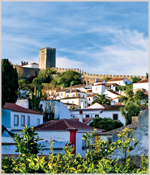 The capital of the area is Coimbra, recently awarded UNESCO World Heritage status. This is a thriving, vibrant city, with a population of 2.3 million, and it is the seat of the oldest university in Portugal, dating from 1290. Since then, it’s been at the centre of Portuguese intellectual life. A visit to the university is a must and the 18th century Baroque library is one of many priceless historical monuments. There are three exquisite gilded chambers housing 300,000 leather-bound texts behind imposing wooden doors, probably some 30 feet tall. The precious books in this library are safeguarded from insect damage by resident bats, which sleep behind the serried rows of ancient tomes by day and eat insects by night; the mahogany reading tables are covered in cloth overnight to protect them from bat excrement. I would visit Portugal simply to re-visit the library – it is so fascinating and so totally extravagant.
The capital of the area is Coimbra, recently awarded UNESCO World Heritage status. This is a thriving, vibrant city, with a population of 2.3 million, and it is the seat of the oldest university in Portugal, dating from 1290. Since then, it’s been at the centre of Portuguese intellectual life. A visit to the university is a must and the 18th century Baroque library is one of many priceless historical monuments. There are three exquisite gilded chambers housing 300,000 leather-bound texts behind imposing wooden doors, probably some 30 feet tall. The precious books in this library are safeguarded from insect damage by resident bats, which sleep behind the serried rows of ancient tomes by day and eat insects by night; the mahogany reading tables are covered in cloth overnight to protect them from bat excrement. I would visit Portugal simply to re-visit the library – it is so fascinating and so totally extravagant.
The university is nicknamed the ‘Little Vatican’ as it is protected by ancient charter and even the police have to request permission from the Dean before they enter the campus. That permission can be refused because, within the ancient walls, the Dean wields as much power as the President of the Republic.
Needless to say, Coimbra is a must but there are also other interesting ancient cities to explore, like Aveiro on the coast and Viseu, the gateway to the Estrela National Park. Each area has its own local cuisine and specialities. Some of the most famous and delicious Portuguese cheeses come from the Estrela region.
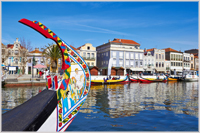 These two provinces, the Centro/Heart of Portugal and the Alentejo, together make ideal fly-drive holiday combinations. There is some stunning accommodation, too, with two of my personal favourite hotels found in the adjacent regions. The Casa da Insua is a wonderful 18th century Baroque confection, located on the outskirts of Viseu in Centro, where you can try your hand at making cheese in the dairy if you wish, afterwards exploring an excellent in-house museum and art gallery. In the Alentejo, just outside Evora, is the Covento do Espinheiro, a historic monument once lived in by the Kings of Portugal – a superlative hotel that manages to be friendly while offering the best of cuisine and comfort. The manager’s tour of the hotel and a wine tasting in the former monastery’s water cistern is not to be missed.
These two provinces, the Centro/Heart of Portugal and the Alentejo, together make ideal fly-drive holiday combinations. There is some stunning accommodation, too, with two of my personal favourite hotels found in the adjacent regions. The Casa da Insua is a wonderful 18th century Baroque confection, located on the outskirts of Viseu in Centro, where you can try your hand at making cheese in the dairy if you wish, afterwards exploring an excellent in-house museum and art gallery. In the Alentejo, just outside Evora, is the Covento do Espinheiro, a historic monument once lived in by the Kings of Portugal – a superlative hotel that manages to be friendly while offering the best of cuisine and comfort. The manager’s tour of the hotel and a wine tasting in the former monastery’s water cistern is not to be missed.
The true character of Portugal lies very much within these two regions and yet so many of us simply drive through on our way south or north. I urge you to spend a little time exploring them; you’ll enjoy a relaxing and inspiring taste of the real Portugal.
Silver Travel Advisor recommends Sunvil Discovery











